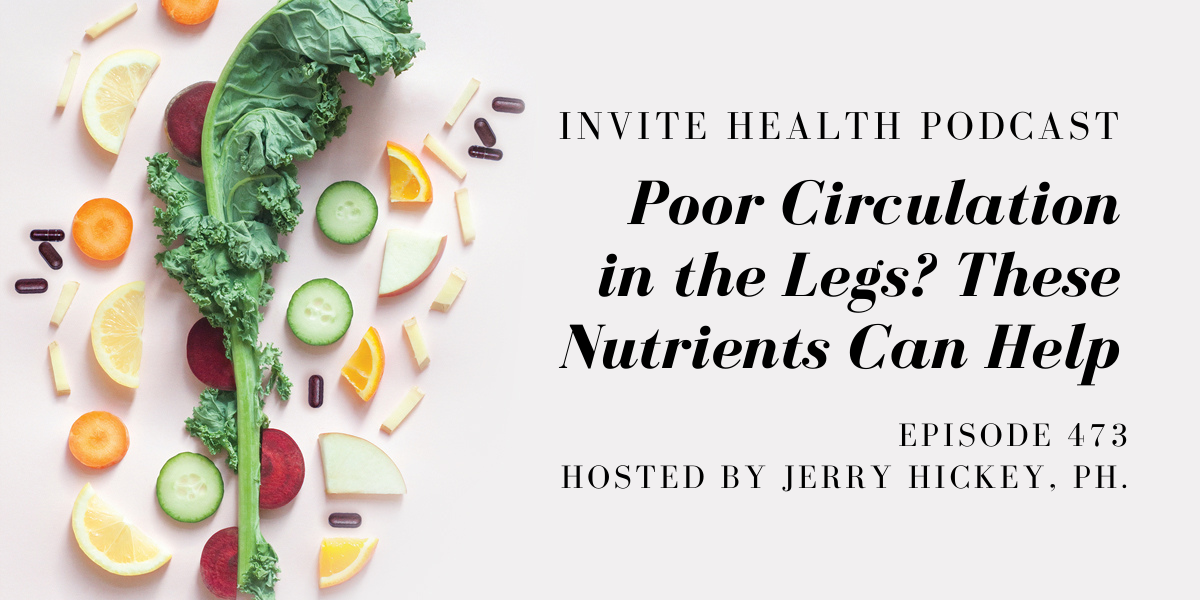Poor Circulation to the Legs? These Nutrients Can Help – InVite Health Podcast, Episode 475

circulation
InViteⓇ Health Podcast, Episode hosted by Jerry Hickey, Ph.
Subscribe Today!
Today we’re discussing poor circulation to your legs, its ramifications and what can help. It’s actually called PAD, which stands for Peripheral Arterial Disease. It’s also called Peripheral Vascular Disease. It occurs when the arteries that carry oxygen-rich blood from your heart to your limbs narrow and stiffen. This is typically because of a buildup of plaque inside the vessel walls. This can slow down or diminish the flow of blood to your limbs, so it typically affects your legs. If you walk fast or you’re walking uphill or up the stairs, you can experience real leg pain.†
What leads to poor circulation in your legs?
Some of the risk factors for poor circulation in the legs can actually be controlled. This includes smoking, obesity, high blood pressure, high cholesterol, elevated blood sugar and high levels of the metabolite homocysteine.†
There are risk factors that lead to clogged arteries in the legs that are out of our control. One of these is being older. As we age, we have some level of a decline of blood flow. A family history of heart disease and kidney disease can also lead to this. Sadly, African Americans have a higher risk of Peripheral Arterial Disease. Research shows that they have double the risk compared to other ethnic groups.†
PAINFUL KIDNEY STONES – INVITE HEALTH PODCAST, EPISODE 44. Listen Now>>
You might not have any symptoms from Peripheral Arterial Disease or you might have very mild symptoms. This is because your arteries haven’t gotten bad enough yet. Once your arteries are more than halfway narrowed by the plaque, then you’re going to have the symptoms. The most common symptom is leg pain and leg cramps when you walk. You get leg cramps, your legs are tired and they become heavy. The problem with this is that it becomes easy to mistake this for other conditions and because of this, Peripheral Vascular Disease is often overlook and not diagnosed until the symptoms get bad.†
How to help this issue
The pain associated with Peripheral Arterial Disease usually eases when you rest. If you have poor circulation, you’re not getting enough oxygen to the muscles in your legs and your leg muscles have to look for an alternate source of fuel, so they go to lactic acid. Lactic acid is only useful as fuels to your muscle for a very short time, after that it causes cramping.†
BEETS HX: THE ULTIMATE PRE-WORKOUT ROUTINE – INVITE HEALTH PODCAST, EPISODE 282. Listen Now>>
The doctor may prescribe medications that can help with this intermittent leg pain, but these can have a lot of side effects. There are also nutrients that can help. One of them is cocoa. There are many ingredients in cocoa that are great for circulation to the brain, but they are also great for circulation to your legs. Cocoa has flavan-3-ols, which are a type of polyphenol, and they can improve the distance a person with Peripheral Arterial Disease can walk without pain. The problem is that, when cocoa is processed into chocolate, it can remove the flavan-3-ols. That’s why I tell patients with Peripheral Arterial Disease to take cocoa, not even dark chocolate.†
Grape seed extract can also help with circulation. When the heart pumps blood to the legs, it releases a gas called nitric oxide that opens the blood vessels so blood can flow smoothly. When you have Peripheral Arterial Disease, you don’t have any nitric oxide in the blood vessel walls. Grape seed stabilizes nitric oxide so it can pump open the blood vessels and allow the blood to flow smoothly to the legs.†
In this episode, Jerry Hickey, Ph. discusses Peripheral Arterial Disease, a condition that impacts the circulation in your legs. He explains what risk factors may impact your circulation and also provides recommendations for nutrients that can help.†
Key Topics:
- How smoking is harmful to the body
- What is homocysteine?
- The severity of symptoms related to PAD
Thank you for tuning in to the InViteⓇ Health Podcast. You can find all of our episodes for free wherever you listen to podcasts or by visiting www.invitehealth.com/podcast. Make sure you subscribe and leave us a review! Follow us on Facebook, Twitter and Instagram at InViteⓇ Health today. We’ll see you next time on another episode of the InViteⓇ Health Podcast.


